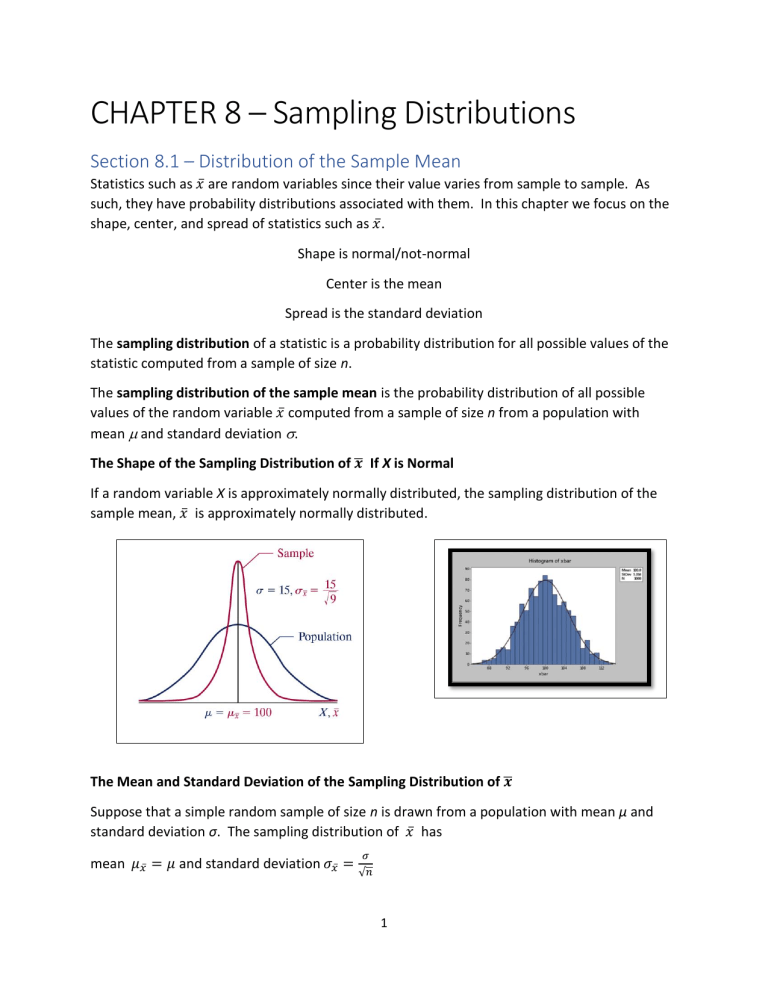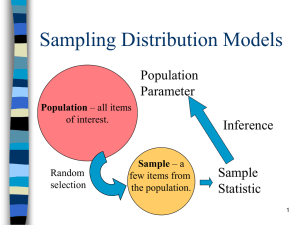
CHAPTER 8 – Sampling Distributions Section 8.1 – Distribution of the Sample Mean Statistics such as 𝑥̅ are random variables since their value varies from sample to sample. As such, they have probability distributions associated with them. In this chapter we focus on the shape, center, and spread of statistics such as 𝑥̅ . Shape is normal/not-normal Center is the mean Spread is the standard deviation The sampling distribution of a statistic is a probability distribution for all possible values of the statistic computed from a sample of size n. The sampling distribution of the sample mean is the probability distribution of all possible values of the random variable 𝑥̅ computed from a sample of size n from a population with mean and standard deviation . ̅ If X is Normal The Shape of the Sampling Distribution of 𝒙 If a random variable X is approximately normally distributed, the sampling distribution of the sample mean, 𝑥̅ is approximately normally distributed. ̅ The Mean and Standard Deviation of the Sampling Distribution of 𝒙 Suppose that a simple random sample of size n is drawn from a population with mean μ and standard deviation σ. The sampling distribution of 𝑥̅ has mean 𝜇𝑥̅ = 𝜇 and standard deviation 𝜎𝑥̅ = 𝜎 √𝑛 1 The standard deviation of the sampling distribution of 𝑥̅ , 𝜎𝑥̅ is called the standard error of the mean. What role does n, the sample size, play in the standard deviation of the distribution of the sample mean? ____________________________________________________________________________ Example: The IQ, X, of humans is approximately normal with mean = 100 and standard deviation = 15. Compute the probability that a simple random sample of size n = 10 results in a sample mean greater than 110. That is, compute Shape is normal Center is the mean 𝜇𝑥̅ = 100 Spread is the standard deviation 𝜎𝑥̅ = 𝜎 √𝑛 = 15 √10 . = 4.743 . 𝑃(𝑥̅ ≥ 110) =________________ StatCrunch Command____________________________________________________________ ̅ If X is NOT Normal The Shape of the Sampling Distribution of 𝒙 Sample size is n = 4 Sampling distribution is skewed symmetrical? Mean, 𝜇𝑥̅ =_______________ and Standard deviation , 𝜎𝑥̅ = 2 𝜎 √𝑛 =____________________ Sample of size n = 30 Sampling distribution is skewed symmetrical? Mean, 𝜇𝑥̅ =_______________ and Standard deviation , 𝜎𝑥̅ = 𝜎 √𝑛 =____________________ 1. The mean of the sampling distribution of the sample mean is equal to the mean of the underlying population, and the standard deviation of the sampling distribution of the sample 𝜎 mean is 𝑛 regardless of the size of the sample. √ 2. The shape of the distribution of the sample mean becomes approximately normal as the sample size n increases, regardless of the shape of the underlying population. The Central Limit Theorem Regardless of the shape of the underlying population, the sampling distribution of 𝑥̅ becomes approximately normal as the sample size, n, increases. If the distribution of the population is unknown or not normal, then the distribution of the sample mean is approximately normal provided that the sample size is greater than or equal to 30. Example: Weight Gain During Pregnancy The mean weight gain during pregnancy is 30 pounds, with a standard deviation of 12.9 pounds. Weight gain during pregnancy is skewed right. An obstetrician obtains a random sample of 35 low-income patients and determines their mean weight gain during pregnancy was 36.2 pounds. Does this result suggest anything unusual? 3 𝜇𝑥̅ =___________________ 𝜎𝑥̅ = 𝜎 √𝑛 =________________ 𝑃(𝑥̅ ≥ 36.2) =_________________ Interpretation_______________________________________________________________ 8.2 Distribution of the Sample Proportion Suppose that a random sample of size n is obtained from a population in which each individual either does or does not have a certain characteristic. The sample proportion, denoted (read “p-hat”) is given by 𝑝̂ = 𝑥 𝑛 where x is the number of individuals in the sample with the specified characteristic. The sample proportion, 𝑝̂ is a statistic that estimates the population proportion, p. 4 Example: Computing a Sample Proportion The Harris Poll conducted a survey of 1200 adult Americans who vacation during the summer and asked whether the individuals plan to work while on summer vacation. Of those surveyed, 552 indicated that they plan to work while on vacation. Find the sample proportion of individuals surveyed who plan to work while on summer vacation. 𝑝̂ = 𝑥 = 𝑛 Interpretation________________________________________________________________ ̂ Sampling Distribution of 𝒑 For a simple random sample of size n with a population proportion p, • The shape of the sampling distribution of 𝑝̂ is approximately normal provided 𝑛𝑝(1 − 𝑝) ≥ 10 • The mean of the sampling distribution of 𝑝̂ is 𝜇𝑝̂ = 𝑝 • The standard deviation of the sampling distribution of 𝑝̂ is 𝜎𝑝̂ = √ 𝑝(1−𝑝) 𝑛 Example: Describing the Sampling Distribution of the Sample Proportion Suppose the proportion of Americans who believe that the state of moral values in the United States is getting worse is 0.76 (Based on a study conducted by the Gallup organization). Suppose we obtain a simple random sample of n = 60 Americans and determine which believe that the state of the moral values in the United States is getting worse. Describe the sampling distribution of the sample proportion for Americans with this belief. The United States has over 300 million people, so the sample of n = ________ is less than _______% of the population size and 𝑛𝑝(1 − 𝑝) =____________________ The distribution of 𝑝̂ is approximately __________________with mean, 𝜇𝑝̂ =___________ and standard deviation, 𝜎𝑝̂ =_________________ 5 Example: Compute Probabilities of a Sample Proportion According to the National Center for Health Statistics, 15% of all Americans have hearing trouble. In a random sample of 120 Americans, what is the probability at most 12% have hearing trouble? The data was obtained by a random sample. There are over 300 million people in the United States, so the sample size of n = _________ is definitely less than _____% of the population size. 𝑛𝑝(1 − 𝑝) = _______________________________, therefore, the shape of the distribution of the sample proportion 𝑝̂ is approximately ____________________ with mean, 𝜇𝑝̂ =___________ and standard deviation, 𝜎𝑝̂ =_________________ 𝑃(𝑝̂ ≤ 0.12) =____________________ Interpretation: _________________________ _______________________________________ StatCrunch Command___________________________________________________________ Now suppose that a random sample of 120 Americans who regularly listen to music using headphones results in 26 having hearing trouble. What might you conclude? 𝑥 The sample proportion is 𝑝̂ = 𝑛 =________________ We want to know if obtaining a sample proportion of __________ from a population whose proportion is assumed to be 0.15 is unusual. 𝑃(𝑝̂ ________________) =____________________ Interpretation _________________________________________________________________ 6






